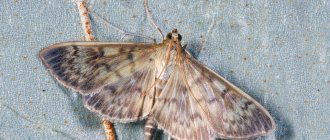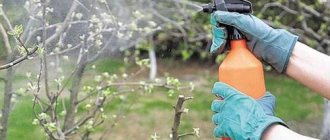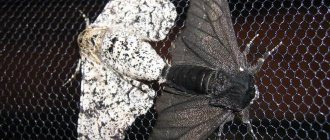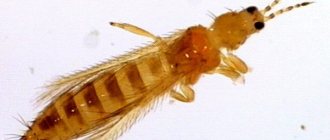The flour beetle is a small heat-loving insect that is a malicious pest of flour, grain, nuts, dried fruits and other food supplies. This pest can parasitize in large granaries, bakeries, shops and in residential buildings and apartments. In our country, it is widespread, and in the southern regions the parasite lives in any premises, and in the northern regions - only in heated ones.
Description
The Suriname mucoed is a very common type of household pest. The length of its flat and elongated body is about 2-3.5 mm. The integument is colored brown, which can have different shades: from light to dark. The surface of the chitin is matte with short, tightly fitting hairs. The head, like the body, has a flattened shape. There are antennae on the head, the length of which is no more than half the length of the body.
The elytra of the mucous eater are rectangular at the base; there are dotted grooves on the surface. The wings of this insect are well developed - it is capable of flight and is generally quite mobile.
The red flour beetle is heat-loving and for its normal reproduction and development it requires an air temperature that will be in the range from +25 to +27°C with a relative humidity of 65%. Under such conditions, 44 days are enough for the development of one generation.
On a note! If the air temperature drops below +16°C, mucous eaters stop reproducing! And at 0°C the insect dies within 22 days, at -5°C – 13 days!
Who are mucoeds
Mucoeds are representatives of the family of flat beetles. The beetles are distinguished by their small, elongated bodies of various shades of brown. The most common species are the Suriname and red mucoed.
The latter are usually light and have a rusty tint, their length is no more than 2 mm. The body is covered with long hairs. On the head there are antennae directed in different directions.
Flour eaters are tiny creatures, but very voracious
Red mucoeds live for about 6 months. Females lay eggs in food, from which larvae hatch a few days later. The larva develops for 3 months, after which it turns into a pupa. During its life, the red mucous eater makes about 5 clutches (up to 100 eggs in total). Its larva is cream-colored and reaches 4 mm in length. At the end of its abdomen there are 2 hook-shaped outgrowths. The pupa is light yellow, with spines at the posterior end. It, like the larva, is covered with hairs.
The Surinam mucoed is darker and longer than the red one. It can reach 3.5 mm in size. The insect's body is covered with short hairs adjacent to the body. The antennae of this mucous eater are short.
The Suriname mucoed beetle has barbs on its sides, which is why it is called the saw beetle.
Flat grooves stretch along its back. Males are distinguished by the presence of teeth on the lower part of the thighs. The larva of the Suriname mucoede is white or yellow. Her head is brown, and spots of the same color can be seen on her back. The posterior end is slightly rounded. The pupa has 6 spines on the sides, and two straight ones at the end of the abdomen.
Suriname mucoeds live up to three years. The female lays eggs in groups of 30 pieces. After 12 days the larvae hatch. After 3 weeks they pupate and remain in this state for no more than 10 days.
Insects live on almost every continent, but they especially love warm places. The most favorable temperature for their life and development is 23–25 ° C. Air humidity plays an important role. At low temperatures, the mucous beetle stops developing and dies faster.
This insect is very voracious; it damages all food supplies. Flour eaters prefer flour and cereals, but can eat dry animal food, dried fruits, vegetables, pasta and bread products. Bugs mainly appear in barns, granaries, houses and shops.
By releasing enzymes and leaving feces, mucoeaters can harm human health. Eating contaminated cereals often causes an allergic reaction.
In addition, waste products left by insects contribute to the rapid appearance of mold in stocks.
Maliciousness
How dangerous is the Suriname mucoed? First of all, because it is capable of severely damaging large reserves of flour, cereals and grain in a fairly short period of time. In addition, this pest can often be found in dried fruits and vegetables, often in those that are already moldy.
On a note! In just one time, a female mucoed is capable of laying from 100 to 600 eggs. She lays her eggs on a food substrate, which the emerging larvae subsequently feed on!
Flour eater is also dangerous because it reduces the value of contaminated food products to absolute zero. Eating them is highly discouraged, as there is a high probability of an allergic reaction.
Insects in cereals
No one is safe from the appearance of insects in cereals. They may appear there while the grain is in the elevator or granary.
And after the products are packaged and ready for sale, they will end up in our kitchens.
Bugs
It is better not to use cereals where insects have infested, but to throw them away to birds or animals.
Mucoeds
Science knows several types of mucoeds. They are not very different from each other in appearance or in the harm they cause. Some differences exist biologically.
Small bugs in cereals
The bug that most often appears in cereals, the Surinam mucoed, is relatively small in size.
Its body reaches 1.8-3.5 millimeters. Its body is elongated and flattened, black-brown in color, the surface of which is matte. Quite short hair growths are adjacent to the chitinous cover.
The loose and flattened head is pushed forward. The mustache, slightly less than half the length of the body, thickens slightly towards the top. In males, on the posterior segments, on the lower part, there is a tiny tooth.
These insects do not have the ability to fly.
The red mukoed reaches a length of one and a half to two and a half millimeters. The body is narrow, rusty-yellow in color, covered with hairs. Thin thread-like antennae of the same length as the body. These beetles have the ability to fly beautifully.
The smallest insect in the class of mucoeds is the short-whiskered mucoed. The size of the body reaches only 1.5-2.4 millimeters. Its narrow body is quite thick and has a rusty-yellow color. The chitinous shell has silky hairs. The beetles have two pairs of wings and fly in calm weather on sunny days.
Bread grinder
These insects are the most voracious and not picky bugs in food. Their cylindrical shape and brown body reaches 4 millimeters in length and is covered with hairs.
Moth larvae also spoil cereals
food moth
In addition to beetles, larvae up to 1 cm long and with a dark-colored head can be found in cereal stocks. These are food moth larvae.
Adult butterflies do not have a mouthpart or a functioning digestive system.
That's why they don't eat. But the larvae cause no less harm to products than bugs.
Ways of penetration of mucoed into the apartment
Initially, the mucous beetle lives, of course, in the wild, but does not live long. Most often it can be found under the bark of trees and in rotten stumps. If possible, it immediately moves to industrial enterprises: mills, barns, bakeries, feed mills, etc. There the development of the insect is more successful.
On a note! Despite the fact that the flour beetle is a threat to various products, it will only damage certain stocks - the moisture content of which is at least 15-16%! If the product is too dry, then the insects gather in groups and contaminate it with excrement and shed shells, thereby increasing the moisture content of the stock!
Where do flour eaters come from in our kitchens? The pest usually enters apartments in the following way:
- in bags with contaminated flour and cereals, from where they are subsequently distributed throughout the house;
- flour beetles are often found in packages of low-quality grain feed and pet food;
- Within an enterprise and even a populated area, mucoids can spread through active dispersal.
Thus, it turns out that in most cases we ourselves bring the parasite into our home along with contaminated food. But, be that as it may, when you find a flour beetle in the kitchen cabinet, you need to clearly know how to get rid of it, because only timely and correct measures will help you quickly remove it from the apartment.
How to get rid of the Suriname mucoed: effective methods of prevention
Considering the high fertility and viability of the pest, the only way to combat it is prevention:
- Drying and heat treatment of stored grain. Dry food has an unfavorable effect on the insect; at a humidity of 12-16% and a temperature below 16 ° C, it dies.
- Keeping stocks of different products separate from each other.
- Spring and autumn fumigation of warehouses.
Since, when wintering in heated warehouses and granaries, females of the Suriname mucoed lay eggs in secluded corners, seams and crevices, one of the most effective methods of destroying them is “Peshka-B” sulfur bombs. The advantage of the product is that with their help you can quickly and efficiently process large planting areas with minimal labor costs.
To do this, just place the checkers throughout the entire warehouse area and set it on fire, after closing all the windows and doors. The active substance does not burn, but sublimes together with the pyrotechnic mixture and spreads in the form of an aerosol throughout the room, penetrating into places that are difficult to reach by hand. This produces a minimal amount of sulfur dioxide, which causes corrosion of the metal elements of the room.
You can obtain more detailed information about the effectiveness and methods of purchasing these products from our managers.
Fighting methods
So, before using any poisonous or repellent remedy for mucous, you must do the following:
- empty kitchen cabinets and nightstands of food, dishes and other items and remove all spilled supplies - flour, cereals, etc.;
- Dilute a tablespoon of vinegar in a liter of water and wipe all surfaces of the kitchen unit with the resulting solution;
- in order to destroy mucous eaters that could hide in hard-to-reach places, you need to bring the water to a boil and pour boiling water over all the cracks (if you are absolutely sure that this measure will not harm your furniture!);
- Wash jars and other containers in which flour and cereals are stored thoroughly with laundry soap and treat with boiling water;
- if supplies were stored in linen bags, then the latter should be soaked in a salt solution, and then dried without rinsing;
On a note! After such an event, female mucoeds will no longer lay eggs on the bags!
Folk remedies
Now it’s time to choose what to poison the mukoeater with. If there are few insects, then folk remedies can be used to destroy them.
- These pests do not like the smell of bay leaves and garlic.
- Pyrethrum - this powder is a real poison for the mucous eater. You can buy it at the pharmacy. The powder is scattered on the shelves of kitchen cabinets or placed in fabric bags. After one and a half to two weeks, the old drug should be thrown away and fresh powder should be added. Two treatments will be enough.
- You can also remove beetles using simple bait. Mix equal amounts of borax, powdered sugar and any finely ground cereal. We lay out the finished mixture on pieces of paper in the kitchen cabinets. Flour eaters will begin to eat the poisoned bait and die from the poison present in its composition.
- It is recommended to use sticky traps for mucous beetles. They are placed in the kitchen and other rooms where the parasite was found and are changed as they are filled.
Advice! They will work especially effectively together with repellent substances - the beetle runs away from the unpleasant odor and ends up in a sticky trap!
Insecticides
In most cases, the above-described means and methods help get rid of the Surinam mucoed, and both poisons and repellents show high effectiveness. However, if the insects have managed to breed and there are too many of them, then in this case you cannot do without insecticides.
So, for mucoed you can use:
- "Dichlorvos";
- "Raptor";
- "RAID";
- "Combat" etc.
All of them are used according to the same scheme. First, food and utensils should be removed from the premises and access to people and animals should be restricted. Next, close the windows and spray the product evenly on all surfaces, including the inside of cabinets and bedside tables. After treatment, the room is closed and the time prescribed in the instructions is maintained. Finally, wet cleaning is carried out.
It is quite possible to destroy a mucous eater in an apartment on your own. The main thing is that if a pest is detected, immediately take steps to eliminate it, and then carefully inspect cereals, flour and other bulk products purchased in the store.
Insects in cereals
No one is safe from the appearance of insects in cereals. They may appear there while the grain is in the elevator or granary.
And after the products are packaged and ready for sale, they will end up in our kitchens.
Bugs
It is better not to use cereals where insects have infested, but to throw them away to birds or animals.
Mucoeds
Science knows several types of mucoeds. They are not very different from each other in appearance or in the harm they cause. Some differences exist biologically.
Small bugs in cereals
The bug that most often appears in cereals, the Surinam mucoed, is relatively small in size.
Its body reaches 1.8-3.5 millimeters. Its body is elongated and flattened, black-brown in color, the surface of which is matte. Quite short hair growths are adjacent to the chitinous cover.
The loose and flattened head is pushed forward. The mustache, slightly less than half the length of the body, thickens slightly towards the top. In males, on the posterior segments, on the lower part, there is a tiny tooth.
These insects do not have the ability to fly.
The red mukoed reaches a length of one and a half to two and a half millimeters. The body is narrow, rusty-yellow in color, covered with hairs. Thin thread-like antennae of the same length as the body. These beetles have the ability to fly beautifully.
The smallest insect in the class of mucoeds is the short-whiskered mucoed. The size of the body reaches only 1.5-2.4 millimeters. Its narrow body is quite thick and has a rusty-yellow color. The chitinous shell has silky hairs. The beetles have two pairs of wings and fly in calm weather on sunny days.
Bread grinder
These insects are the most voracious and not picky bugs in food. Their cylindrical shape and brown body reaches 4 millimeters in length and is covered with hairs.
Moth larvae also spoil cereals
food moth
In addition to beetles, larvae up to 1 cm long and with a dark-colored head can be found in cereal stocks. These are food moth larvae.
Adult butterflies do not have a mouthpart or a functioning digestive system.
That's why they don't eat. But the larvae cause no less harm to products than bugs.
Harm from bugs
Few people would like a Surinamese flour eater in their apartment. What makes it dangerous is, first of all, that the beetle destroys cereal reserves. This can seriously hit the owner’s budget, since products infected with the pest are no longer suitable for food. The flour eater transfers toxic substances to products, after consumption of which allergic reactions and gastrointestinal disorders may occur. For this reason, it is necessary to carefully monitor the cleanliness of cereals, even if you have never encountered this problem.
Fighting mucoeds at work
Eliminating the possibility of mucoid occurrence is the main task of food sector companies. and production premises are treated with special chemicals.
In addition, methods of heating, cooling and cleaning grain are used; grains are thoroughly dried and stored at low temperatures. This helps prevent the bug from appearing.
Quality departments monitor the purity of each batch of products sent to the counter. However, an unfair attitude towards this stage of production is present and bears fruit - bugs appear in the customers’ kitchen and infect other products.
How to poison pests with boric acid
As soon as you notice that insects have appeared in your apartment, you need to come up with a plan on how to get rid of cockroaches or ants. You need to start getting rid of them by identifying the places where they accumulate. Most often they live where there is high humidity. Therefore, it is best to scatter cockroach balls around sinks and toilets. Sometimes even boric acid alone will be effective. If you deprive pests of access to water and pour acid into a container, then cockroaches will have no choice - they will drink it. Often such measures are sufficient, but if the invasion is too extensive, then it is worth preparing boric acid against ants or cockroaches in the form of bait.
Important! To get the best effect, do not increase the acid concentration in the bait. We need to make sure that the insect does not die immediately, but has time to return to the nest and bring the poisoned food to the others.
To ensure that insects eat the poison, you need to make an “appetizing bait”. Most often, boric acid with egg is used against cockroaches:
- You will need one yolk (raw), which must be carefully mixed with boric acid powder (about 5 g). Roll the resulting thick mass into small balls.
Another effective “dish” for ants, which includes boric acid with an egg, is prepared as follows:
- Boil one medium potato and an egg. Now make a puree from one yolk and boiled potatoes. Add boric acid powder (1 tbsp) and mix thoroughly. Roll into small balls.
For bait, you can use components such as sunflower oil, flour or granulated sugar:
- Mash the boiled yolk with the active ingredient, add a little vegetable oil;
- Make a paste of raw yolk and acid (5 g), add sugar (2 tbsp), stir thoroughly;
- You can first mix all the dry ingredients (acid, flour, powdered sugar) and dilute with water until you get a dough that is easy to roll into balls.
Before laying out delicious bait, make sure that insects cannot reach any other food. The effect of the bait will be noticeable in a couple of days. And to consolidate the result, it is better to use other means in combination.
Prevention
To prevent the appearance of beetles, you need to take some preventive measures. It is not enough to simply keep bags of cereal in the refrigerator. It is necessary to make bags from canvas material, which are boiled for half an hour in a salty solution. After that, dry them and iron them. If you store cereals in such bags, you can protect yourself from the appearance of flour eaters. You can also put purchased cereals in the freezer for several days.
If you have bugs in the kitchen, then do not despair, thinking that you are an unscrupulous housewife. The flour eater can be brought on clothes or with cereal from the store, and this is not a bit of the person’s fault. The main thing is to know how to get rid of bugs in cereals and act immediately.
Clean kitchen areas regularly, treat them with disinfectants, and check all products thoroughly.











